Algorithmic Trading Market Size
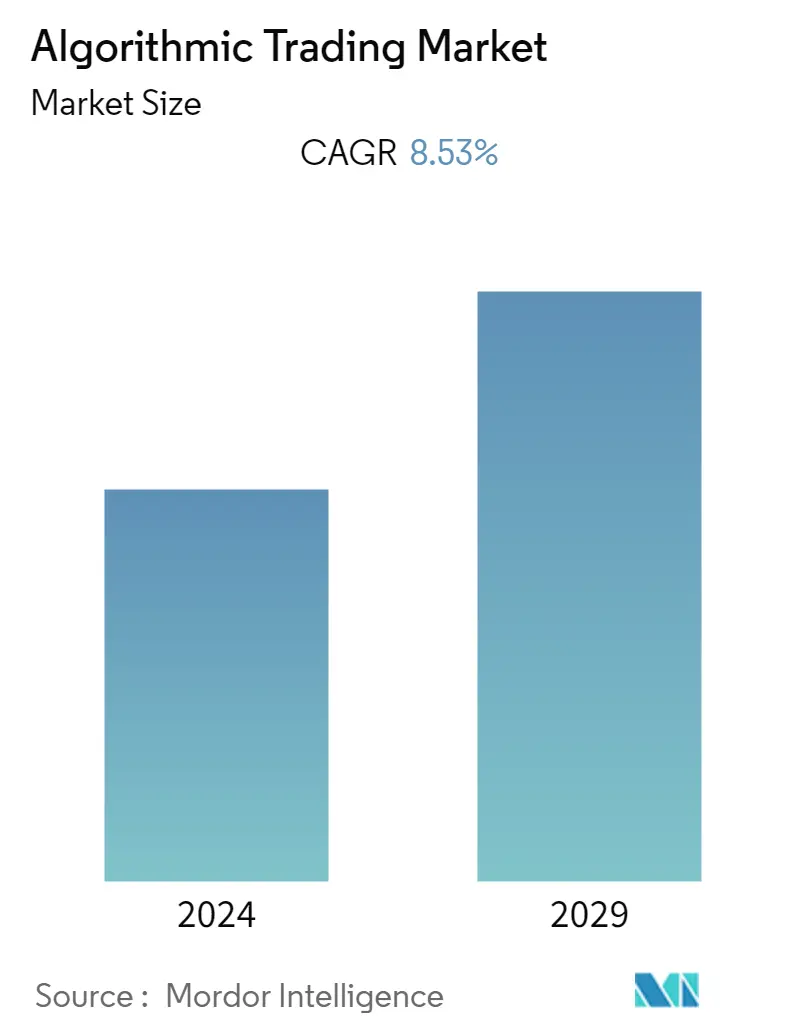
| Study Period | 2019 - 2029 |
| Base Year For Estimation | 2023 |
| CAGR | 8.53 % |
| Fastest Growing Market | Asia Pacific |
| Largest Market | North America |
| Market Concentration | Low |
Major Players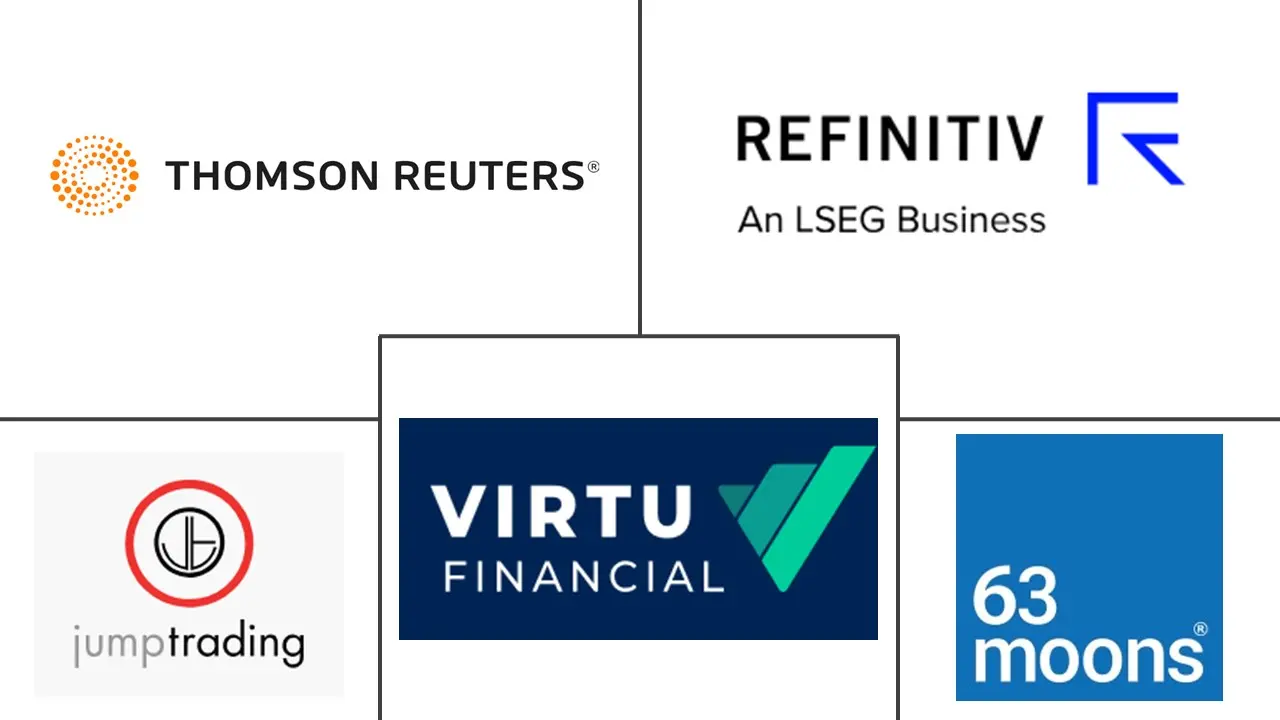
*Disclaimer: Major Players sorted in no particular order |
Algorithmic Trading Market Analysis
The Algorithmic Trading Market was valued at USD 14.42 billion in the current year and is expected to register a CAGR of 8.53%, reaching USD 23.74 billion in five years. Traders have traditionally used market surveillance technology to keep track of their trading operations and investment portfolios. Applications with built-in intelligence, like algorithmic trading, can explore the market for various opportunities based on the yield and other parameters the user specifies.
- The need for the algorithmic trading industry is anticipated to be driven by favorable governmental rules, rising demand for quick, reliable, and efficient order execution, increasing demand for market surveillance, and declining transaction costs. Large brokerage firms and institutional investors use algorithmic trading to reduce the expenses of bulk trading. Additionally, it is anticipated that the development of artificial intelligence (AI) and financial service algorithms will create attractive market expansion opportunities. A rise in the demand for cloud-based solutions is also anticipated to support the growth of the algorithmic trading market.
- The technological revolution has altered how one can interact with the world and do business. But, far from reaching maturity, the revolution continues to unfold, revealing even more disruptive technologies and approaches capable of disrupting entire industries and spawning significantly new business models. Advanced and intelligent trading systems have evolved with markets and technological advances in recent years. These systems have become increasingly popular in recent years as they enable different levels of automated trading.
- Since the introduction of matching engines in modern exchanges, algorithmic trading has been used globally. By removing human restrictions, such technological advancements have enhanced the capacity of markets to process orders and trades. As a result, the studied market's timeline shifted from seconds to milliseconds, and market surveillance was transferred from the trading pit to computers. Whether conducted by a government or an exchange, market surveillance safeguards market integrity and protects participants from unethical behavior.
- While algorithmic trading has its advantages, it can also amplify the negative trends in the market studied by causing crashes (so-called "flash crashes") and immediate loss of liquidity. The instant loss of liquidity can restrain market growth.
- The COVID-19 pandemic led to increased dependence on technologies owing to the global lockdowns. The volatile market conditions, high trading volume, and drive for rapid digital transformation to cope with the remote working environment have all contributed to the uptick in algorithmic trading.
Algorithmic Trading Market Trends
On-cloud Deployment Segment is expected to drive the Market Growth
- Cloud technologies provide ways to automate processes and efficiently store and maintain data. In addition, cloud-based trading offers the benefits of remote servers to process trades. This reduces onsite IT infrastructure costs and augments the cloud's power to test and model trades.
- In the age of cloud deployment, cloud-based algorithmic trading platforms are projected to play a crucial role in the growth of the market, owing to various benefits, such as obtaining maximum profits, as cloud-based trading solutions enable traders to automate their trading process, easy trade data maintenance, scalability, cost-effectiveness, and effective management.
- Cloud-based trading works on the cloud computing model, which uses networks of remote servers generally accessed over the internet to manage, store, and process data. Attributed to the convenience of the cloud, traders can deploy algorithmic trading in the cloud to check new trading strategies, backtest, and run-time series analysis while executing trades.
- It is well known that most stock transactions are automated in significant stock markets using applications or bots implementing a trading strategy. Recently, an emerging trend in the financial services industry has been the movement of trading solutions, like algorithmic trading solutions, to the cloud. More and more traders have been using algorithmic trading solutions based on the cloud for the past few years.
- One of the significant benefits of the cloud is business agility, leveraging the ability to easily and quickly access technology and continuous innovation provided by cloud service providers, along with a pay-as-you-go model, which enables a trader to experiment and pilot new technologies and solutions without high upfront investments. More specifically, there are various use cases and benefits for capital markets firms extending their on-premises solutions to the cloud or building cloud-native solutions. According to Flexera Software, As of 2023, 72 percent of the enterprise respondents indicated that they had deployed a hybrid cloud in their organization.
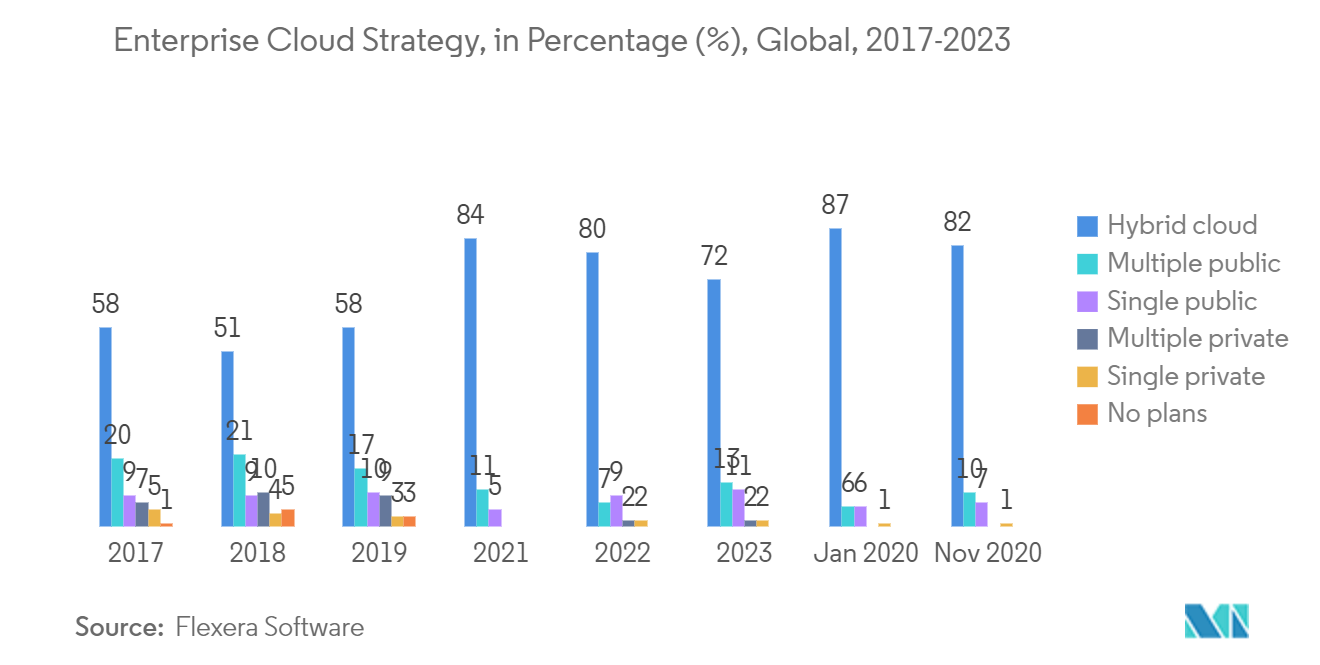
North America is Expected to Hold Significant Market Share
- North America is expected to have the most significant market share in the market studied. The main drivers of market growth throughout the forecast period are the rising investments in trading technologies (such as blockchain), the growing presence of algorithmic trading suppliers, and the expanding government backing for international trading in the region.
- As algorithmic trading strategies, including high-frequency trading (HFT), have grown more widespread in the US securities markets, the potential for these strategies to adversely impact market and firm stability has likewise increased.
- Modern technology is rapidly transforming the formats of conventional investment models by automating all associated trading procedures, enabling the development of a secure and effective ecosystem that will be accessible to all potential investors.
- The algorithmic trading market in North America operates within a regulatory framework governed by agencies such as the U.S. Securities and Exchange Commission (SEC) and the Financial Industry Regulatory Authority (FINRA). These regulatory bodies have implemented rules and guidelines to ensure market integrity, fair practices, and risk management.
- Algorithmic trading has gained substantial traction among institutional investors, including asset management firms, hedge funds, and pension funds. These entities employ algorithmic trading strategies to enhance efficiency, optimize execution, and manage risk. The availability of sophisticated trading platforms and access to market data have facilitated the widespread adoption of algorithmic trading.
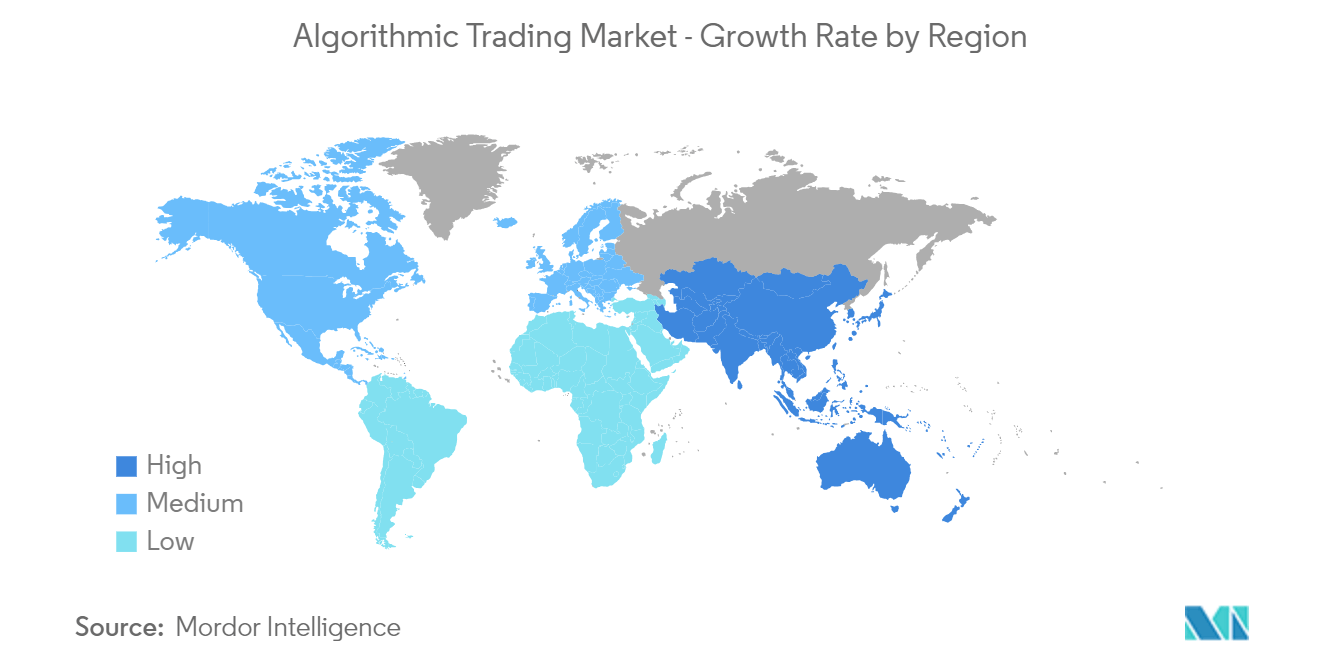
Algorithmic Trading Industry Overview
The algorithmic trading market is highly fragmented with the presence of major players like Thomson Reuters, Jump Trading LLC, Refinitiv Ltd, 63 Moons Technologies Limited, and Virtu Financial Inc. Players in the market are adopting strategies such as partnerships and acquisitions to enhance their product offerings and gain sustainable competitive advantage.
In June 2023, Virtu Financial launched Alert+, a new workflow solution available in POSIT Alert that enhances the features of POSIT Alert by providing automated routing to Virtu's Covert execution algorithm to seek non-displayed liquidity.
In October 2022, Multi Commodity Exchange of India Limited (MCX) partnered with 63 Moons Technologies for software technology services for three months to continue to experience seamless trading.
In October 2022, Refinitiv, an LSEG business, announced the introduction of a secure, personalized, and frictionless global digital onboarding solution to assist businesses in streamlining their approach to onboarding customers. Refinitiv's digital customer onboarding solution offers a fully configurable user interface, allowing organizations to provide the product application process that can be delivered via the web, mobile, and API.
Algorithmic Trading Market Leaders
-
Thomson Reuters
-
Jump Trading LLC
-
Refinitiv Ltd
-
63 Moons Technologies Limited
-
Virtu Financial Inc.
*Disclaimer: Major Players sorted in no particular order
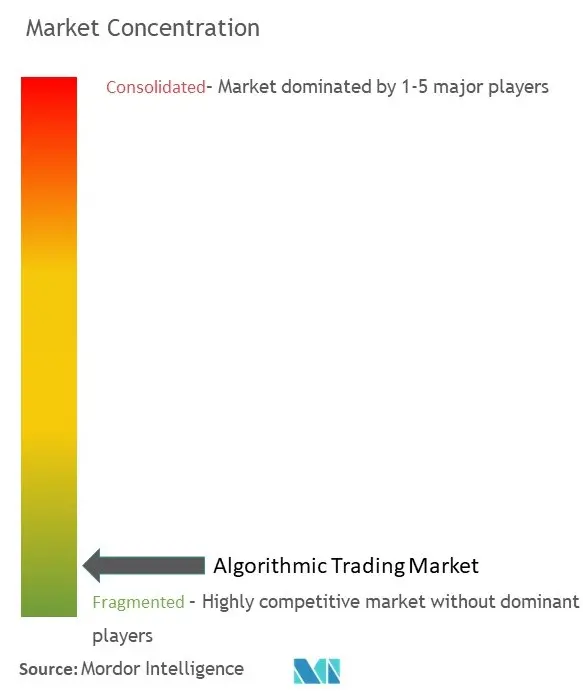
Algorithmic Trading Market News
- June 2023: DoubleVerify, one of the leading software platforms for digital media measurement, data, and analytics, announced the launch of DV Algorithmic Optimizer, an advanced measure and optimization offering with Scibids, one of the global leaders in artificial intelligence (AI) for digital marketing. The combination of DV's proprietary attention signals and Scibids' AI-powered ad decisioning enables advertisers to identify the performing inventory that maximizes business outcomes and advertising ROI without sacrificing scale.
- June 2023: KuCoin Futures has announced its recent API partnership with Kryll, one of the leading automated trading bot creation platforms. This innovative collaboration aims to revolutionize futures trading by integrating Kryll's algorithmic trading bots and TradingView signal features into the KuCoin Futures platform.
Algorithmic Trading Market Report - Table of Contents
1. INTRODUCTION
- 1.1 Study Assumptions and Market Definition
- 1.2 Scope of the Study
2. RESEARCH METHODOLOGY
3. EXECUTIVE SUMMARY
4. MARKET INSIGHTS
- 4.1 Market Overview
-
4.2 Industry Attractiveness - Porter's Five Forces Analysis
- 4.2.1 Bargaining Power of Suppliers
- 4.2.2 Bargaining Power of Buyers/Consumers
- 4.2.3 Threat of New Entrants
- 4.2.4 Threat of Substitute Products
- 4.2.5 Intensity of Competitive Rivalry
- 4.3 Impact of COVID-19 on the Market
-
4.4 Technology Snapshot
- 4.4.1 Algorithmic Trading Strategies
- 4.4.1.1 Momentum Trading
- 4.4.1.2 Arbitrage Trading
- 4.4.1.3 Trend Following
- 4.4.1.4 Execution-based Strategies
- 4.4.1.5 Sentiment Analysis
- 4.4.1.6 Index-fund Rebalancing
- 4.4.1.7 Mathematical Model-based Strategies
- 4.4.1.8 Other Algorithmic Trading Strategies
5. MARKET DYNAMICS
-
5.1 Market Drivers
- 5.1.1 Rising Demand for Fast, Reliable, and Effective Order Execution
- 5.1.2 Growing Demand for Market Surveillance Augmented by Reduced Transaction Costs
-
5.2 Market Restraints
- 5.2.1 Instant Loss of Liquidity
6. MARKET SEGMENTATION
-
6.1 By Types of Traders
- 6.1.1 Institutional Investors
- 6.1.2 Retail Investors
- 6.1.3 Long-term Traders
- 6.1.4 Short-term Traders
-
6.2 By Component
- 6.2.1 Solutions
- 6.2.1.1 Platforms
- 6.2.1.2 Software Tools
- 6.2.2 Services
-
6.3 By Deployment
- 6.3.1 On-cloud
- 6.3.2 On-premise
-
6.4 By Organization Size
- 6.4.1 Small and Medium Enterprises
- 6.4.2 Large Enterprises
-
6.5 By Geography
- 6.5.1 North America
- 6.5.2 Europe
- 6.5.3 Asia Pacific
- 6.5.4 Latin America
- 6.5.5 Middle East and Africa
7. COMPETITIVE LANDSCAPE
-
7.1 Company Profiles
- 7.1.1 Thomson Reuters
- 7.1.2 Jump Trading LLC
- 7.1.3 Refinitiv Ltd
- 7.1.4 63 Moons Technologies Limited
- 7.1.5 Virtu Financial Inc.
- 7.1.6 MetaQuotes Software Corp.
- 7.1.7 Symphony Fintech Solutions Pvt. Ltd
- 7.1.8 Info Reach Inc.
- 7.1.9 ARGO SE
- 7.1.10 IG Group
- 7.1.11 Kuberre Systems Inc.
- 7.1.12 Algo Trader AG
- *List Not Exhaustive
8. INVESTMENT ANALYSIS
9. MARKET OPPORTUNITIES AND FUTURE TRENDS
** Subject To AvailablityAlgorithmic Trading Industry Segmentation
Algorithmic trading, also known as automated trading, algo-trading, or black-box trading, is a method of implementing trade orders with automated pre-programmed trading instructions. Considering variables like volume, price, and time, the programs send small slices of the order to the market over a period.
The Algorithmic Trading market is segmented by types of traders (institutional investors, retail investors, long-term traders, short-term traders), by component (solutions (platforms, software tools), services), by deployment (on-cloud, on-premise), by organization size (small and medium enterprises, large enterprises), by geography (North America, Europe, Asia Pacific, Latin America, Middle East, and Africa).
The market sizes and forecasts are provided in terms of value in USD for all the above segments.
| By Types of Traders | Institutional Investors | |
| Retail Investors | ||
| Long-term Traders | ||
| Short-term Traders | ||
| By Component | Solutions | Platforms |
| Software Tools | ||
| By Component | Services | |
| By Deployment | On-cloud | |
| On-premise | ||
| By Organization Size | Small and Medium Enterprises | |
| Large Enterprises | ||
| By Geography | North America | |
| Europe | ||
| Asia Pacific | ||
| Latin America | ||
| Middle East and Africa |
Algorithmic Trading Market Research FAQs
What is the current Algorithmic Trading Market size?
The Algorithmic Trading Market is projected to register a CAGR of 8.53% during the forecast period (2024-2029)
Who are the key players in Algorithmic Trading Market?
Thomson Reuters, Jump Trading LLC, Refinitiv Ltd, 63 Moons Technologies Limited and Virtu Financial Inc. are the major companies operating in the Algorithmic Trading Market.
Which is the fastest growing region in Algorithmic Trading Market?
Asia Pacific is estimated to grow at the highest CAGR over the forecast period (2024-2029).
Which region has the biggest share in Algorithmic Trading Market?
In 2024, the North America accounts for the largest market share in Algorithmic Trading Market.
What years does this Algorithmic Trading Market cover?
The report covers the Algorithmic Trading Market historical market size for years: 2019, 2020, 2021, 2022 and 2023. The report also forecasts the Algorithmic Trading Market size for years: 2024, 2025, 2026, 2027, 2028 and 2029.
What is driving the growth of the Algorithmic Trading Market?
The algorithmic Trading Market growth is driven by a) Technological advancements b) Increased market liquidity c) Demand for fast, efficient trading mechanisms in financial markets
Algorithmic Trading Platform Industry Report
The global algorithmic trading market is experiencing significant growth, driven by the increasing adoption of automated trading solutions across various segments such as stock markets, foreign exchange, and cryptocurrencies. North America continues to lead in market share, due to advanced technological integration and regulatory support. The surge in cloud-based solutions, which enhance efficiency and reduce costs, is making these systems highly attractive to financial institutions and traders. Additionally, the integration of AI and ML is propelling the market forward by enabling faster and more accurate data analysis, crucial for algorithmic trading.
Market players are expanding their geographic presence and improving their offerings to leverage the growing demand. This trend is fostering growth in both established and emerging markets, as indicated by ongoing algorithmic trading statistics. Companies are increasingly relying on algorithmic trading to enhance trading strategies and operational efficiency. The market size continues to expand as more institutional investors, retail investors, long-term traders, and short-term traders adopt these technologies.
The industry analysis highlights the importance of market data and market forecast in understanding the market growth. Market leaders are focusing on market segmentation to cater to different organization sizes, including small and medium enterprises and large enterprises. The market outlook remains positive, with significant market predictions indicating continued growth.
For detailed insights, including market share, size, and revenue growth rate, access a free report PDF download from Mordor Intelligence™ Industry Reports, which provides a comprehensive algorithmic trading analysis and market forecast outlook. The industry information and industry research provided in these reports are crucial for understanding market trends and market value. The industry sales and industry size are also key metrics that highlight the overall market overview.
In conclusion, the algorithmic trading market is poised for substantial growth, driven by technological advancements and the increasing need for efficient trading solutions. The market review and market segmentation provide a clear picture of the current market landscape, while the industry outlook and industry trends offer valuable insights into future developments.



